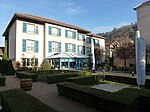Vienne Cathedral
1250s establishments in France1251 establishments in EuropeBurial sites of the BosonidsChurches completed in 1251Churches in Isère ... and 3 more
France Roman Catholic cathedral stubsRoman Catholic cathedrals in FranceVienne, Isère

Vienne Cathedral (French: Cathédrale Saint-Maurice de Vienne) is a medieval Roman Catholic church in the city of Vienne, France. Dedicated to Saint Maurice, it was the episcopal see of the primate of the ancient Septem Provinciae and of the Archdiocese of Vienne until its abolition confirmed by the Concordat of 1801. It today serves as co-cathedral of the Diocese of Grenoble-Vienne. The present-day building, erected from 1130 onwards, was classified a French national heritage site (monument historique) in the list of historic monuments of 1840.
Excerpt from the Wikipedia article Vienne Cathedral (License: CC BY-SA 3.0, Authors, Images).Vienne Cathedral
Rue du Pape Calixte II, Vienne
Geographical coordinates (GPS) Address External links Nearby Places Show on map
Geographical coordinates (GPS)
| Latitude | Longitude |
|---|---|
| N 45.524166666667 ° | E 4.8730555555556 ° |
Address
Cathédrale Saint-Maurice
Rue du Pape Calixte II
38200 Vienne
Auvergne-Rhône-Alpes, France
Open on Google Maps






